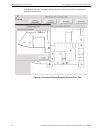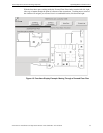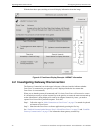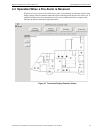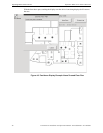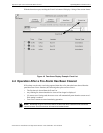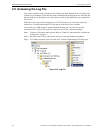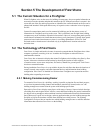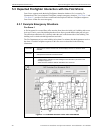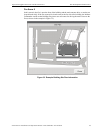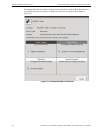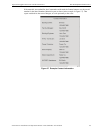39FIRSTVISION™ Installation and Operation Manual - P/N: 53034:Rev: A2 10/29/07
Section 5 The Development of FIRSTVISION
5.1 The Current Situation for a Firefighter
When Firefighters arrive on the scene of a building fire emergency, they must gather information to
accurately assess the situation and plan their attack on the fire. Prompt assessment is essential—the
sooner the seat of the fire and its progression are identified, the sooner the attack on the fire can be
planned and launched. With speed and accuracy of response comes a reduction in loss of property
and life.
Current fire annunciation panels used in commercial buildings provide the primary source of
information for Firefighters arriving on the scene. This is particularly true at night when building
occupants may not be available to report their observations. However, current alarm panels provide
sensor/detector information in formats that are not always easily interpreted. Typically, these panels
present activated smoke/heat detectors as items in a scrolling alphanumeric Event List. Each
activated smoke or heat detector is described only by an alphanumeric location code and an
activation time.
5.2 The Technology of FIRSTVISION
FIRSTVISION is simple and intuitive because it cannot be assumed that the Firefighters have either
computer experience or training in its use. It enables the Firefighter to reduce the time to
understand the situation.
F
IRSTVISION has an interactive display that orients Firefighters to the building using floor by floor
layouts. It decreases situation assessment time by showing the location of water supplies,
evacuation routes, access routes and points, fire barriers, shutoffs for gas and power. F
IRSTVISION
also shows structural hazards.
During installation F
IRSTVISION is set up with the layouts for each floor that show the locations of
sensors, hazards, water supplies, and other important devices and information about building
configuration. F
IRSTVISION is installed in a location where Firefighters are expected to enter the
building when responding to an event.
5.2.1 Making Commissioning Easier
To customize FIRSTVISION for a building—making it possible to pinpoint fires and their progress,
to see where important building features and hazardous materials are located, and so on—the
building manager must commission the system with building-specific data.
Data to drive F
IRSTVISION display comes from a wide range of sources. Sources include drawings
of building floor and site plans from CAD files, sensor data from building fire panels, location data
for objects such as standpipes, and textual data associated with hazardous materials documentation.
One of Honeywell’s goals was to design a software application that gave the building manager the
flexibility to pull in the best data available from different but existing sources. The resulting
Configuration Tool provides an interface into which building managers enter or add fire detection
information that customizes F
IRSTVISION to the building.




